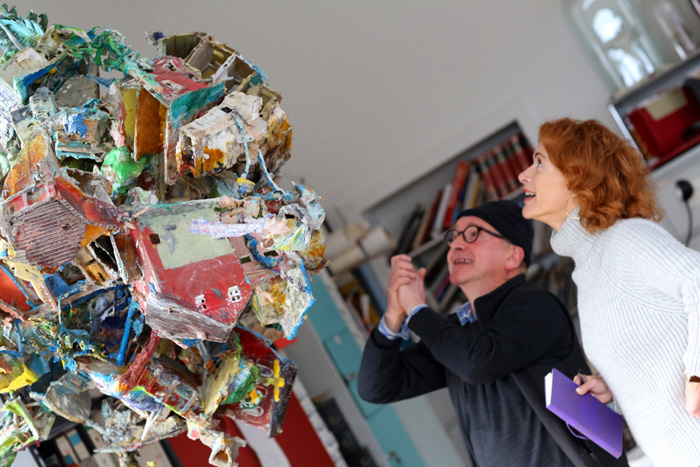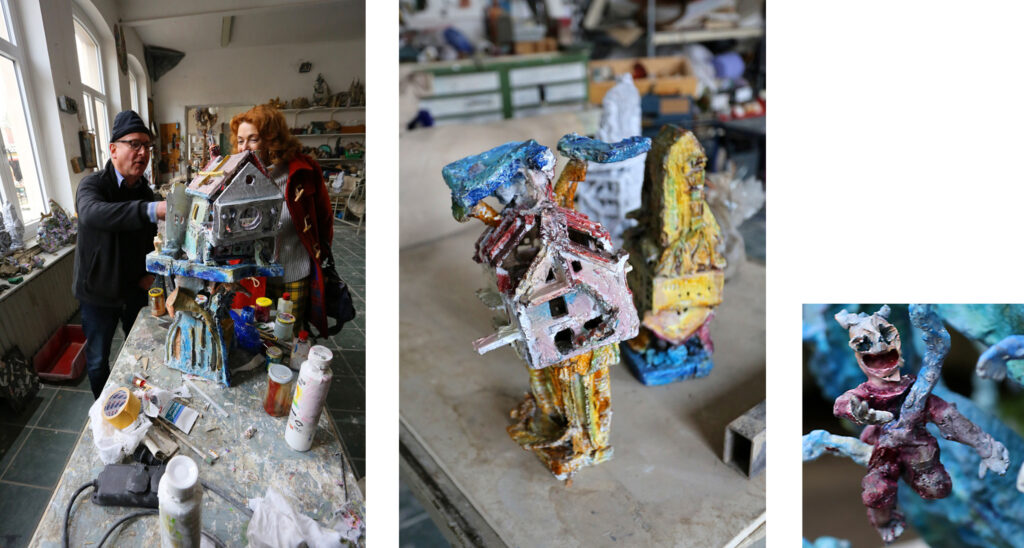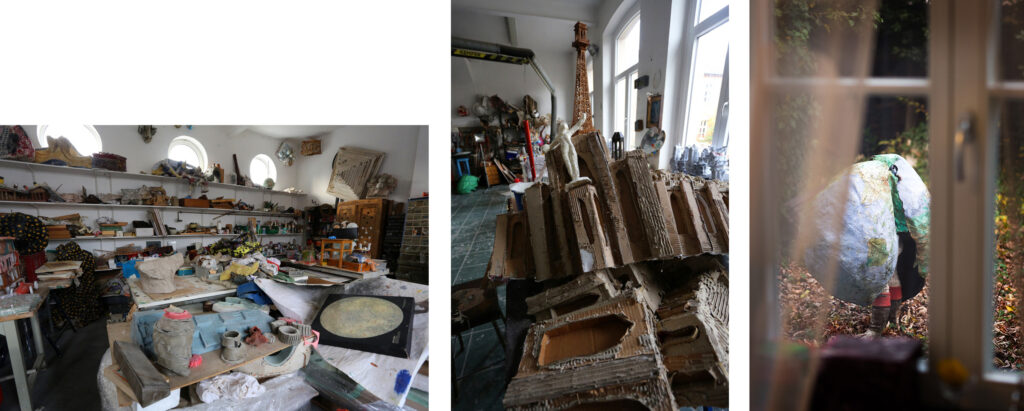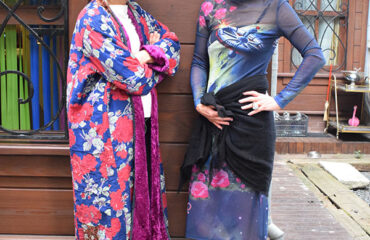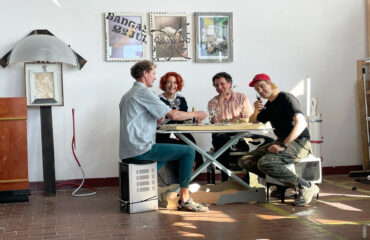Photos: Natascha Romboy
18.1.2017: It’s a sunny winter afternoon. For today’s visit to the studio, I only have to travel a short distance. The artist whom I will introduce today lives and works in my home town of Mönchengladbach. This is sculptor and painter, Thomas Virnich. Several of his works are well known to me from the public sphere as well as museum exhibits. The Düsseldorf Academy graduate and Professor of the Braunschweig University of Fine Arts is currently being featured in Lugano. I’ve heard a lot about his unusual work. It is a former school that has been continually undergoing a transformation into a place of art since 1989.
The property is surrounded by a brick wall typical for this building. Somewhere is a big green gate with a latch on the side, where I am to make myself noticed. Slowly I walk along the wall and spy the gate and latch. At the same time, I see Thomas Virnich beckoning us. Us – because I am fortunate to once again be accompanied by a photographer. This time it is Natascha Romboy.
Together we go through the gate. The former school yard must have been transformed into an enchanted magic garden. How else could I explain how I’m magically surrounded by sculptural structures that are reminiscent of fantastic mythical creatures or seem to have originated from the former geometric figures? There are some oddities mixed in: the body of a disused mannequin poses lasciviously in a wire basket, a large pink plastic pig grins at us defiantly, and saints try to assert themselves between the sculptures – all seem to have strayed into this magical garden. “I love to rummage through flea markets to get inspiration”, explains the artist, who laughs as he notices my slightly confused reaction to the pig.
Image 1: Canal Street (work in Progress) – Image 2: Wurzelköpfe (Work in progress) – Image 3: Ziegelbau (2015) – Image 4: Fußballwelt (2005)– Image 5 and 6: Examples of junk
The seemingly lurching and billowing shapes of sculptures inspire me as well as the variety of materials used. In addition to works from ceramic, wood, and metal are works from paper and wax. Virnich shows me the warehouse of his material depot. Next to it is a room with kilns. “The kilns allow me to fire my ceramic work locally”, he explains. One of the kilns is of impressive size. Ideal for the witch in Hansel and Gretel, I think.
Next we enter the first studio space. A hodgepodge of paint tubes, brushes, tools, and indefinable items is piled up on the shelves and workbenches, thus reflecting the classic studio space of our imagination. But there are also cleared areas, where individual pieces are obviously being processed. One can recognise different stages of development – an opportunity for me to find the first similarities. I see crooked houses – some open and some closed – often with small terraces and colourful chimneys. The windows are round or angular and large or small. The individual architectural elements are blends of the profane and sacred. They seem to float on pedestals that look a bit like tree trunks – or more precisely, something plant-like. They are covered with ceramic glazes reminiscent of icing.
Image 1: Models of Helter Skelter (2015/2016) – Image 2: Detailed view „Geister“
However, one pedestal seems to have forgotten its part. “What’s that?”, I ask Thomas Virnich, pointing at the structure in front of me. “This is a spaceship”, he answers. I’m irritated. A house on a spaceship? Now I definitely need a bit of input. I’m reassured that “It’s all not that complicated.” “There are classic issues and topics in my work. The questions are: Where do we come from, where we live, and where are we going?” It becomes clear that in the natural and plant world, home, and spacecraft, all of these issues are united. “It’s primarily about protecting, enveloping, and packing – altogether about confronting the world around us. Our personal world in which we live and which we shape – but also the world as one of the planets of the universe. The covers everything from the Big Bang to the present day”.
“And how do the typical spirit figures of Virnich find their place?”, I ask as I point to one. Explanation: in many cases, the figures in his work are reminiscent of spirits or angels. “The processes of transformation are to be symbolised”. I think I have just discovered the background. “No. No. This is much easier”, he dismisses. “When I hollow out my sculptures, separate characters that look a bit like ghosts often appear. I like to put them in new openings – like here”, he explains with the example of a small figure that hovers at a window opening. How embarrassing! This shows once again how quickly art can be interpreted…
We go to the next room. Overall, a similar picture, but everything a bit denser and more sculpturing. The pleasure of forms and kneading is felt here. It is enticing to be allowed to touch anywhere. “Surely this is cardboard”, I think as I recognise the typical grooves of corrugated board. Upon closer inspection, I realise that it is ceramic. I am deceived several more times on my tour. We then go up a flight of stairs. On the shelf on the stairs, I notice the many globes. He not only seems to create worlds but also collect them…
Image 1: A glimpse into the artist’s studio – Image 2: Forms of Mailänder Dom (2016) – Image 3: View from the window of the studio
Upstairs, completed works are kept. On open shelves, in showcases, on windowsills, on the floor, and in the cabinets – simply everywhere. It is a sort of survey show. For the first time, one can see paintings and artist’s books. “I set up my painting studio at our house in Majorca – in Sóller. I’m trying separate everything a bit,” he explains. In some sculptures I recognise classical architectural forms or historical styles – but with a modern twist. A Renaissance building seems to have collapsed into itself. Now, rising again like a Phoenix, is a cubist church featuring an Asian paper-folding technique. The “Rocket Cathedral” is adorned with rosaries. “Is this meant to be religiously charged? Or to put it another way – does your art deal with religion?”, I would like to know. “My art deals with everything that has to do with us humans. Religion is as important as the confrontation with architectural forms. Both accompanies and reflects the history of human development. However, the rosaries are something of a gimmick”, explains Virnich. His expression suggests that “one can’t take everything so seriously”.
Image 1: Glimpse into the “Store”-room – Image 2: Petersdom (2004) – Image 3: Basilius-Kathedrale (2003) – Image 4: Kubistische Kirche (2015)
In his office, he shows me a very special world, namely his personal world. Bright and winking, he presents the colourful globe that hangs down from the ceiling (see title photo). “This is my planet school”. Again, it seems that formerly symmetrical and orderly building exploded. The individual elements have reassembled to yield a round form. At this point, it occurs to me that his father was rector and art teacher. It must have been quite stimulating to have been allowed to set up a studio here, of all places. “Yes. Indeed. Even as a child, I was allowed to potter about with my brother [the painter Professor Winfried Virnich] in the art room of the school. Many lovely memory are associated with this”, he confirms.
Image 1: Planet Schule (2002) – Image 2: Elke Backes and Thomas Virnich
All in all, the entire former school building seems to be occupied by art. But is there still space to live? Just in time for answering my thought, we are called for coffee. Across the courtyard is the private living area. We head straight into the cosy kitchen of the Virnich family, which is reminiscent of the Kunterbunt Villa . While Thomas Virnich looks for “normal” milk and grumbles about his daughter, who had once again bought “this terrible soy milk”, I look around the room. Between and on the furniture course, one can also see art – for the first time, representational paintings. “I thought you only made abstract paintings?”, I ask puzzled. “I generally do not make such a distinction” is his surprising answer, which gives me pause to think.
If abstraction is viewed as a stylistic reduction to something essential, one can actually recognise smooth transitions from the abstract to the representational in the Virnich process. This becomes clear to me as I reconstruct the process in my mind.
Based on existing forms, the first sculptures arise. These often find a new form in the experimental process – often through omission and dismantling. In terms of abstraction, this accomplished through a reduction of the original form. However, this is not a stylistic reduction. It is rather a classical sculpture process. Although the new form is abstract, it is still clearly representational. This, altogether smooth transitions. But in the sense of a process of abstraction, is something essential – a common core message – highlighted in his works?
As he stressed several times on our tour, protection and wrapping are of central importance in his work. Is there perhaps a hidden core message? Whether skin, cave, house, spaceship, rock, or nature – everything protects and envelops anyone or anything. This suddenly occurs to me. But when looking at his forms and figures, do we think of protection? We do feel protected in closed spaces based on a sound framework. However, here we see open forms that are demonstratively detached from static order. These literally turn our world upside down, thus undermining its stability.
Amazingly, we do not perceive this instability because the observation of these colourful, fantastic, and bizarre worlds inspires us. Does Thomas Virnich want us to perceive the fantasy, which inspires us to make our own world a bit more colourful, so that this can protect and envelop us?
“… ich mach mir die Welt, widewide wie sie mir gefällt (I make world as I like it) …”, I think elated as I leave the studio grounds. Is it a coincidence that I think back to my favourite children’s show again?
More information
… about the artist: http://thomasvirnich.de
